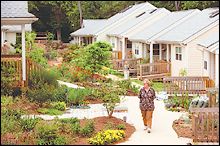
back

|
 |

A Housing Boom, Led by Boomers
By Ron Scherer, The Christian Science Monitor
January 26, 2004
This spring, Cyndi Gruber is planning a trip to Asheville, N.C., a city she thinks she might retire to when she leaves her job as director of alumni relations at Mt. Sinai Hospital in New York.
"If we like what we see, we'll be back in the fall to really get to know it," she says.
Ms. Gruber is not alone. The baby-boomer generation - estimated at 76 million - is just starting to retire. Like Gruber, they are out shopping for new homes, often not in the cities where they currently live.
And now economists believe this demographic trend may be one of the forces driving the US housing market.
"As baby boomers are leaving the labor force, or preparing to leave the labor force, they are lining up their second home/retirement home," says Kathleen Camilli, an economist at Credit Suisse Asset Management in New York. "Don't be surprised by a stronger than average US housing sector in this decade." Even more immediately, she adds, "The strength in this sector could cause stronger than expected GDP growth this year."
It could be an important boost for the economy. Housing and autos are still two of the main drivers of economic activity, marked by large multiplier effects that provide jobs and work for other industries that supply them. Retirees moving into new houses buy carpets, drapes, television sets, dishwashers, and refrigerators.
In Fort Lauderdale, for example, Richard Zipes, who is building Las Olas River House, a $200 million residential condo complex, says that on average new residents spend $200,000 to $300,000 per unit on everything from new furniture to sound systems - "most of which will be spent primarily in the local area," he says.
Home buying will become even more pronounced by the end of the decade as an increasing number of boomers retire, says Michael Carliner, an economist at the National Association of Home Builders. Since baby boomers have had such a profound effect on everything from the stock market to the types of automobiles driven, he has no doubt the same will be true of housing. "The boomers have dictated what is in excess demand," he says.
Already, some developers can attest to this demand. Mitchell Hochberg, the CEO of Spectrum Communities, a suburban real estate developer, says he is currently building maintenance-free active adult communities for people "55 and better" in Eastport, Long Island, and Monroe, N.J.
In eighteen months, he sold over 100 of the 396 homes in New Jersey - before any of the models were even built. He anticipates the same on Long Island, where last week some 1,200 people signed up to see floor plans. "If we could find the land in this area for another 25 projects, we would be doing them," he says.
While some seniors search for retirement communities in faraway cities, others prefer to live closer to home - near their families, the stores they are accustomed to, and their friends.
That's the case in Chicago, where the Senior Lifestyle Corporation is building retirement communities called "Autumn Green." It's designed for middle-market individuals who don't qualify for government-assisted senior living but can't afford luxury units. "People say, 'I live my whole life here. I'd rather be around my grand-kids and friends,'" says Bill Kaplan, chairman of the company.
Unlike in past decades, today's retirement communities are not just scaled-down housing. "In the past when our parents cashed out, they downsized. Now these new homes are stupendous," says Paul Purcell, a principal in Braddock & Purcell, residential advisers in New York.
In fact, this trend toward larger retirement houses prompted Cottage Companies to build clusters of bungalow-style homes in the Pacific Northwest that sell for between $350,000 and $380,000. "This is not a lesson in austerity and sacrifice,"says Linda Pruitt, a principal.
And, many developers now realize that retirees want more than just shuffleboard. Mr. Kaplan's company is also building a high-end community called "Mangrove Bay" in Jupiter, Fla. He says it has top-of-the-line fitness equipment, a spa, and a restaurant-style dining room. The new Spectrum developments will have concierges, an assortment of classes, and walking trails. Hochberg compares it to living on a cruise ship.
In fact, the amenities, like the retirees, are becoming increasingly sophisticated. Craig Bouck, a principal in the Denver architectural firm Barker Rinker Seacat, says some retirement communities are interested in climbing walls and wireless computer transmissions. And, the obligatory swimming pool is also undergoing a face lift. "They want specialized warm water areas," he explains. "Where they can do aqua aerobics or crank down the volume and do resistance walking."
And, the new pools, says Mr. Bouck, are likely to have ramps that allow a "gracious" entry to a place that is also a social meeting place. "This whole idea of planning for these baby boomers has hit forward thinkers hard."
This is just fine with Ms. Gruber, who is looking forward to having time to work with her stained glass. "I want an active retirement," she says. "It's very exciting."
Copyright © 2002
Global Action on Aging
Terms of
Use | Privacy
Policy | Contact Us
|



